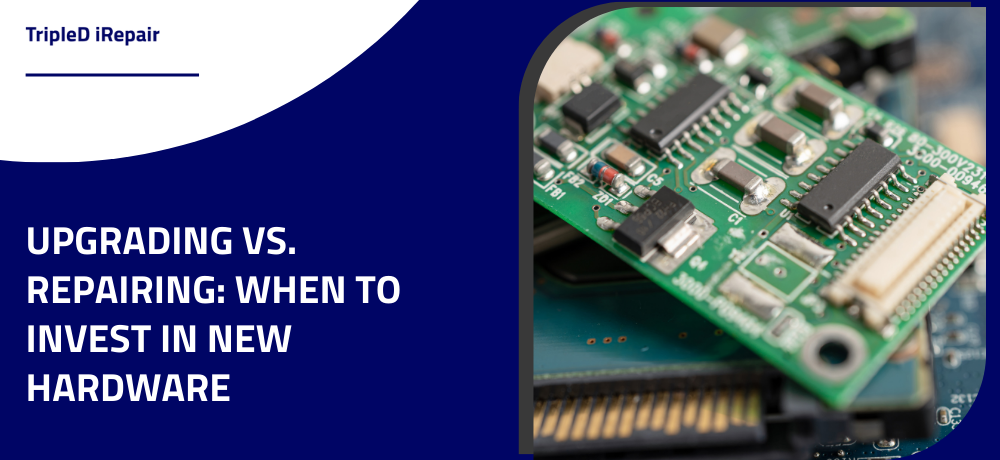
Upgrading vs. Repairing: When to Invest in New Hardware
- TripleD iRepair
In the ever-evolving landscape of technology, the dilemma between upgrading existing hardware and investing in new devices is a common conundrum. At a time when innovations swiftly render our gadgets obsolete, it's essential to navigate the decision between upgrading and repairing wisely. In this blog, we'll explore the factors to consider when faced with the choice of whether to breathe new life into your existing hardware or embrace the advancements of the latest technology.
1. The Evolution of Technology
Understanding the rapid pace at which technology evolves is crucial in making informed decisions about the longevity of your devices. While repairs can address immediate issues, upgrading provides an opportunity to align with the latest features and capabilities.
The Situation: Lagging Performance
As devices age, a noticeable decline in performance may occur. Slow response times, lagging applications, and overall sluggishness can impede productivity and user experience.
Upgrading Path: Embracing Enhanced Performance
Consider upgrading your hardware if performance issues persist despite repair attempts. Newer devices often come equipped with faster processors, increased RAM, and improved efficiency, offering a substantial boost in performance.
Repairing Approach: Addressing Specific Issues
If performance hiccups are isolated to specific components, repairs may be a viable solution. Upgrading individual components, such as a hard drive or memory modules, can extend the life of your device.
2. Outdated Features: Weighing Functional Obsolescence
The Situation: Feature Lag
As technology advances, older devices may lack the features and functionalities that have become standard in newer models. This can limit your ability to leverage the latest software and applications.
Upgrading Path: Embracing Innovation
If your device lacks essential features or struggles with compatibility, upgrading to a newer model ensures access to the latest advancements. This is especially crucial for professionals who rely on cutting-edge tools for work.
Repairing Approach: Targeted Feature Enhancement
In some cases, repairs can introduce specific features to an older device. For example, upgrading software, adding external peripherals, or enhancing specific components may bridge certain feature gaps.
3. Economic Considerations: Balancing Costs
The Situation: Budget Constraints
Budgetary concerns often play a significant role in the decision-making process. Assessing the cost of repairs against the investment in new hardware is essential in making financially prudent choices.
Upgrading Path: Evaluating Long-Term Value
Consider the long-term value of investing in new hardware. While the upfront cost may be higher, the extended lifespan, improved performance, and enhanced features can justify the expense over time.
Repairing Approach: Cost-Effective Solutions
For minor issues or when facing budget constraints, repairs offer a more economical solution. However, it's crucial to weigh repair costs against the potential benefits and longevity of the device.
4. Environmental Impact: Embracing Sustainability
The Situation: E-Waste Concerns
As electronic waste continues to be a global issue, the environmental impact of hardware decisions is gaining prominence. Discarded devices contribute to pollution and resource depletion.
Upgrading Path: Responsible Disposal and Recycling
When upgrading, responsibly dispose of old devices through recycling programs. Many manufacturers and retailers offer initiatives to minimize the environmental impact of electronic waste.
Repairing Approach: Sustainable Device Longevity
Choosing repairs over replacements aligns with sustainable practices by extending the lifespan of your device. Repairing reduces the demand for new manufacturing and helps minimize the environmental footprint.
5. Future-Proofing: Anticipating Technological Trends
The Situation: Anticipating Future Needs
Technological advancements are unpredictable, making it challenging to future-proof your devices. However, considering your long-term needs and the industry's direction can guide your decision-making.
Upgrading Path: Staying Ahead of the Curve
Upgrading allows you to stay abreast of the latest technological trends. If your device struggles to meet current demands, investing in newer hardware ensures compatibility with emerging technologies.
Repairing Approach: Tactical Enhancements
Strategic repairs, such as upgrading software and specific components, can enhance device capabilities. While not a guarantee against future obsolescence, these measures can prolong the usefulness of your device.
The decision between upgrading and repairing is nuanced and depends on various factors, including performance, features, budget, environmental considerations, and future needs. If you are looking for new hardware, then reach out to TripleD iRepair. We recognize the importance of making informed choices about your electronic devices. Whether you opt for an upgrade or choose to repair, our skilled technicians are here to assist you.
Get in touch with us today
To learn more about what we do, please click here. To contact us, please click here.
